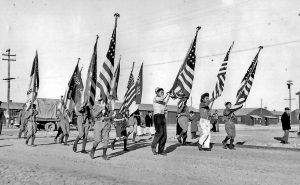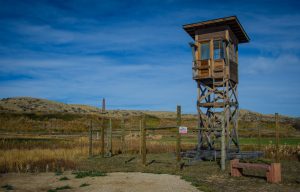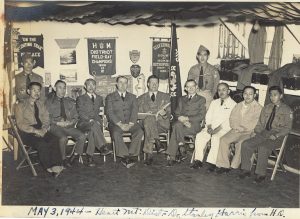A City Behind Barbed Wire
HEART MOUNTAIN, WYOMING — On Feb. 19, 1942, a little more than two months after the Japanese attack on Pearl Harbor launched America’s entry into World War II, President Franklin D. Roosevelt signed Executive Order 9066. That order resulted in nearly 120,000 people of Japanese ancestry — most of them American citizens — being removed from their homes and sent to 10 concentration camps They euphemistically called them relocation centers. One of those camps was built in the Wyoming desert, 12 miles north of Cody in the shadow of craggy Heart Mountain. At an elevation of 8,123 feet, Heart Mountain dominates the landscape for miles.
More than 14,000 Japanese Americans were interred at the Heart Mountain Relocation Center, in shoddily built barracks erected on 46,000 acres in just 60 days by 2,000 workers under the direction of the U.S.  Army Corps of Engineers. Construction began on June 15, 1942. The first evacuees, most of whom had been living in California, arrived two months later, on Aug. 11, 1942. The camp quickly became the third-largest city in Wyoming at the time.
Army Corps of Engineers. Construction began on June 15, 1942. The first evacuees, most of whom had been living in California, arrived two months later, on Aug. 11, 1942. The camp quickly became the third-largest city in Wyoming at the time.
 The families lived in single rooms, often only 16×20 feet — smaller than the average modern one-bedroom apartment. Up to 250 people shared latrine buildings in the center of each half-block, while meals were served in communal dining halls. In early 1943, during the first winter there, the temperature dropped to minus-28 degrees. The wind whipped through the shoddily built barracks with their tarpaper roofs. The prisoners worked to weatherize the barracks, finished an irrigation canal to draw water from the Shoshone River, and built a 300-foot root cellar to store produce grown at the camp. This was called the “Heart Mountain Miracle.” High desert was turned into verdant farmland in less than a year.
The families lived in single rooms, often only 16×20 feet — smaller than the average modern one-bedroom apartment. Up to 250 people shared latrine buildings in the center of each half-block, while meals were served in communal dining halls. In early 1943, during the first winter there, the temperature dropped to minus-28 degrees. The wind whipped through the shoddily built barracks with their tarpaper roofs. The prisoners worked to weatherize the barracks, finished an irrigation canal to draw water from the Shoshone River, and built a 300-foot root cellar to store produce grown at the camp. This was called the “Heart Mountain Miracle.” High desert was turned into verdant farmland in less than a year.
The Heart Mountain Interpretive Center, a Smithsonian Museum affiliate, was built on the site and opened in 2011 to tell the story of innocent men, women and children ripped from their homes. Besides the center, which is filled with compelling exhibits to tell that story, there still stands a single original barrack, since restored, the red-brick chimney of the hospital’s boiler house, and three dilapidated original buildings.
More than 550 babies were born at Heart Mountain in the three years the camp operated, until the war ended in 1945. Camp officials collaborated with detainees to create schools, churches and to provide recreational opportunities — organizing basketball, football, and baseball teams In September 1942, the first of seven Boy Scout troops was initiated within the barbed wire of the Heart Mountain confinement site. Eventually 350 boys joined the Scouts; a similar number of girls became Girl Scouts.
The City Behind Barbed Wire even had its own newspaper, the Heart Mountain Sentinel, an eight-page tabloid published weekly until July 28, 1945, a few months before the camp finally closed and its residents allowed to go home. “Home” was now largely nonexistent, as most of the detainees lost their homes and much of their possessions when sent to the camp. These Japanese Americans left Heart Mountain with $25 and a train ticket to their preferred destination. Many freed internees returned to the West Coast to rebuild their lives. It took more than 40 years, until 1988, before the U.S. government finally apologized for this forced internment.
One irony is that nearly 400 Nisei men (the term for first-generation Americans) were drafted from Heart Mountain into the armed forces. They left a concentration camp in Wyoming to fight for our country, primarily in Europe. About 90 others resisted induction and were tried and convicted. The draft resisters were all pardoned by President Truman in 1947.
My grandfather, Carl Borders, left law enforcement in 1943 to become a professional Boy Scout, a profession he loved and that eventually brought him (and us in 1968) to Longview. As Scout F ield Executive, he was instrumental in helping form the Scout troops inside the Heart Mountain Relocation Center, with the considerable help of adult internees. A final report of community activities published after the Heart Mountain camp was closed in 1945 noted his efforts and those of others: Without their moral support, the tempo of the Scout movement would have been considerably slower.
ield Executive, he was instrumental in helping form the Scout troops inside the Heart Mountain Relocation Center, with the considerable help of adult internees. A final report of community activities published after the Heart Mountain camp was closed in 1945 noted his efforts and those of others: Without their moral support, the tempo of the Scout movement would have been considerably slower.
Eventually there were seven troops and four Cub Scout packs.
I don’t recall talking to Grampa Borders, as we all called him, about his experience at Heart Mountain, but brother Gregg said he did. Grampa said he considered the relocation camps a stain on our country’s history, a terrible thing to do. He became friends with a Japanese American couple with whom he stayed close after they were freed. And he felt that by providing the young internees an opportunity to become Scouts and participate in its activities — a drum and bugle corps, recognition at Courts of Honor and even camping at an abandoned CCC site at Yellowstone National Park, about 100 miles away — at least their lives were being made somewhat more tolerable.
The Heart Mountain Interpretive Center is home to the Mineta-Simpson Institute, intended to “foster empathy, courage, and cooperation in the next generation of leaders.” Norman Mineta served in Congress as a Democrat and in the cabinets of both Bill Clinton and George W. Bush.
Alan Simpson, a member of a well-known Wyoming political family, became a U.S. senator as a Republican. He and Mineta, despite their political differences, became close allies — in large part because they met at Heart Mountain when both were Boy Scouts – Mineta while confined at Heart Mountain, Simpson in nearby Cody. Grampa Borders knew both Alan Simpson, and his father, Milward, who served as governor for a term starting in 1954. Milward Simpson became my dad’s godfather when he was born in 1932, I recently learned.
As governor, M ilward wrote a letter to Grampa Borders when I was born in 1955, congratulating him on the birth of his grandchild. Wyoming is a large state geographically but has the nation’s smallest population. It was even smaller nearly 70 years ago, with fewer than half of its current population of 585,000. More people live in El Paso than in Wyoming.
ilward wrote a letter to Grampa Borders when I was born in 1955, congratulating him on the birth of his grandchild. Wyoming is a large state geographically but has the nation’s smallest population. It was even smaller nearly 70 years ago, with fewer than half of its current population of 585,000. More people live in El Paso than in Wyoming.
It is a long way from Behind the Pine Curtain to Heart Mountain, but for me it was well worth the trip and expense. In memory of Grampa Borders, I joined the nonprofit Heart Mountain Wyoming Foundation, whose goal is to “prevent an injustice like the Japanese American incarceration from every happening again.”
That is certainly my prayer. I think Grampa Borders, gone now for 30 years, would have agreed.
Leave a reply
Fields marked with * are required











